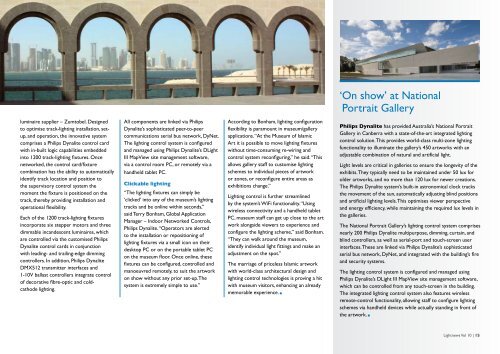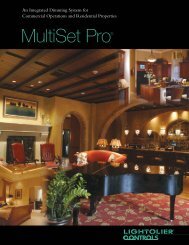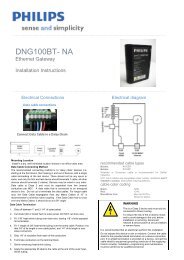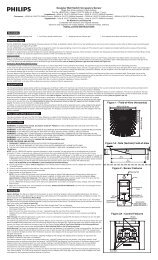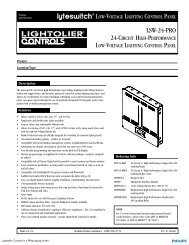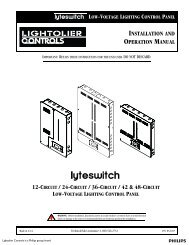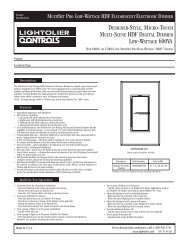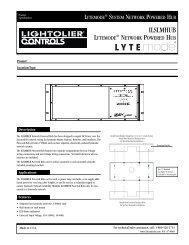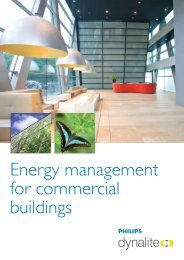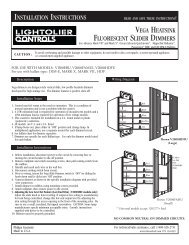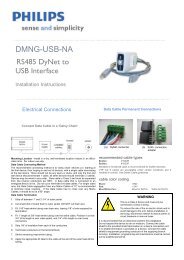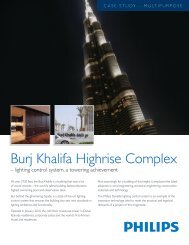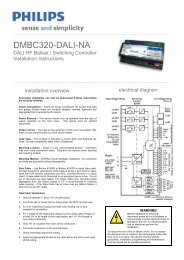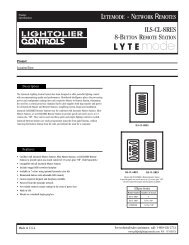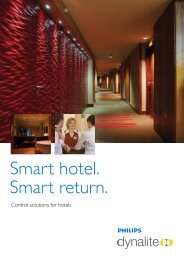Lightnews Vol 10.pdf - Philips Lighting Controls
Lightnews Vol 10.pdf - Philips Lighting Controls
Lightnews Vol 10.pdf - Philips Lighting Controls
You also want an ePaper? Increase the reach of your titles
YUMPU automatically turns print PDFs into web optimized ePapers that Google loves.
luminaire supplier – Zumtobel. Designed<br />
to optimise track-lighting installation, setup,<br />
and operation, the innovative system<br />
comprises a <strong>Philips</strong> Dynalite control card<br />
with in-built logic capabilities embedded<br />
into 1200 track-lighting fixtures. Once<br />
networked, the control card/fixture<br />
combination has the ability to automatically<br />
identify track location and position to<br />
the supervisory control system the<br />
moment the fixture is positioned on the<br />
track, thereby providing installation and<br />
operational flexibility.<br />
Each of the 1200 track-lighting fixtures<br />
incorporate six stepper motors and three<br />
dimmable incandescent luminaires, which<br />
are controlled via the customised <strong>Philips</strong><br />
Dynalite control cards in conjunction<br />
with leading- and trailing-edge dimming<br />
controllers. In addition, <strong>Philips</strong> Dynalite<br />
DMX512 transmitter interfaces and<br />
1-10V ballast controllers integrate control<br />
of decorative fibre-optic and coldcathode<br />
lighting.<br />
All components are linked via <strong>Philips</strong><br />
Dynalite’s sophisticated peer-to-peer<br />
communications serial bus network, DyNet.<br />
The lighting control system is configured<br />
and managed using <strong>Philips</strong> Dynalite’s DLight<br />
III MapView site management software,<br />
via a control room PC, or remotely via a<br />
handheld tablet PC.<br />
Clickable lighting<br />
“The lighting fixtures can simply be<br />
‘clicked’ into any of the museum’s lighting<br />
tracks and be online within seconds,”<br />
said Terry Bonham, Global Application<br />
Manager – Indoor Networked <strong>Controls</strong>,<br />
<strong>Philips</strong> Dynalite. “Operators are alerted<br />
to the installation or repositioning of<br />
lighting fixtures via a small icon on their<br />
desktop PC or on the portable tablet PC<br />
on the museum floor. Once online, these<br />
fixtures can be configured, controlled and<br />
manoeuvred remotely, to suit the artwork<br />
on show without any prior set-up. The<br />
system is extremely simple to use.”<br />
According to Bonham, lighting configuration<br />
flexibility is paramount in museum/gallery<br />
applications. “At the Museum of Islamic<br />
Art it is possible to move lighting fixtures<br />
without time-consuming re-wiring and<br />
control system reconfiguring,” he said. “This<br />
allows gallery staff to customise lighting<br />
schemes to individual pieces of artwork<br />
or zones, or reconfigure entire areas as<br />
exhibitions change.”<br />
<strong>Lighting</strong> control is further streamlined<br />
by the system’s WiFi functionality. “Using<br />
wireless connectivity and a handheld tablet<br />
PC, museum staff can get up close to the art<br />
work alongside viewers to experience and<br />
configure the lighting scheme,” said Bonham.<br />
“They can walk around the museum,<br />
identify individual light fittings and make an<br />
adjustment on the spot.”<br />
The marriage of priceless Islamic artwork<br />
with world-class architectural design and<br />
lighting control technologies is proving a hit<br />
with museum visitors, enhancing an already<br />
memorable experience.<br />
‘ On show’ at National<br />
Portrait Gallery<br />
<strong>Philips</strong> Dynalite has provided Australia’s National Portrait<br />
Gallery in Canberra with a state-of-the-art integrated lighting<br />
control solution. This provides world-class multi-zone lighting<br />
functionality to illuminate the gallery’s 450 artworks with an<br />
adjustable combination of natural and artificial light.<br />
Light levels are critical in galleries to ensure the longevity of the<br />
exhibits. They typically need to be maintained under 50 lux for<br />
older artworks, and no more than 120 lux for newer creations.<br />
The <strong>Philips</strong> Dynalite system’s built-in astronomical clock tracks<br />
the movement of the sun, automatically adjusting blind positions<br />
and artificial lighting levels. This optimises viewer perspective<br />
and energy efficiency, while maintaining the required lux levels in<br />
the galleries.<br />
The National Portrait Gallery’s lighting control system comprises<br />
nearly 200 <strong>Philips</strong> Dynalite multipurpose, dimming, curtain, and<br />
blind controllers, as well as serial-port and touch-screen user<br />
interfaces. These are linked via <strong>Philips</strong> Dynalite’s sophisticated<br />
serial bus network, DyNet, and integrated with the building’s fire<br />
and security systems.<br />
The lighting control system is configured and managed using<br />
<strong>Philips</strong> Dynalite’s DLight III MapView site management software,<br />
which can be controlled from any touch-screen in the building.<br />
The integrated lighting control system also features wireless<br />
remote-control functionality, allowing staff to configure lighting<br />
schemes via handheld devices while actually standing in front of<br />
the artwork.<br />
<strong>Lightnews</strong> <strong>Vol</strong> 10 | 15


